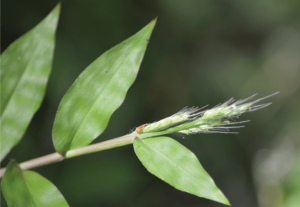What is this?
I’ve been asked by several people what this plant (see photo to the right) is and if it is a weed? Identifying this plant as basketgrass is the easy part. It is common in forests or areas with shade. It forms dense growth in areas that most turf grass struggles to establish as requires very little water and nutrients. The leaves are the key feature that identifies this grass. Basketgrass leaves have a natural wave or ripple to them.
A quick word on Non-Natives

There are three species of Oplismenus (basketgrass or woods grass). Of the three only two are more commonly seen in Putnam County. There are the native species Oplismenus setarius and then there is the non-native Oplismenus burmannii. I highly encourage anyone who plans on keeping this plant to have it identified. The only way, however, is to catch it while it’s flowering, starting in October and ending with the first frost. If you see the flower and would like to have it identified please bring in a section of the plant and it will be sent to a UF/IFAS botanist for confirmation on the species.
Is it a weed?
The saying “it’s all in the eye of the beholder” applies in this instance. Google’s English Dictionary defines a weed as “a wild plant growing where it is not wanted and in competition with cultivated plants.” This means that if you are a turf enthusiast, then most definitely this is a weed. It forms dense growth and can shade out your turf. If it starts growing in your garden or flower beds then control may be needed. However, basketgrass will grow in dense shade, it doesn’t need very much attention (water or fertilizer), and grows fairly quickly. It could be considered an alternative to turf. To see a lawn of O. setarius please click here.
Things to consider if using Basketgrass
There are 2 main considerations if you plan on using basketgrass as a sod alternative.
- Be aware there is a strong possibility that the grass will die back or go dormant during the winter months. In the spring it will grow back fairly quickly.
- Due to this plant’s nature, it will form fairly dense mats, there is concern about animals, like snakes, hiding in the grass. You can mow this grass to ensure that it doesn’t get too dense, therefore making it difficult for wildlife to hide in.
There are message boards where many people have discussed basketgrass (https://turfgrass.com/basketgrass/). This blog is not meant to advocate for or against the usage of basketgrass. However, depending on the situation this plant may be considered a sod alternative. For example, if a portion of a yard is too shaded for turf or if the owner is allergic to common turf grasses. As with any plant make sure you consider if it is the right plant for you and the area you plan to grow it in.
For more information:
Basketgrass, A Common Landscape Weed
Florida Native Plant Society: Bristle Basketgrass
 1
1
